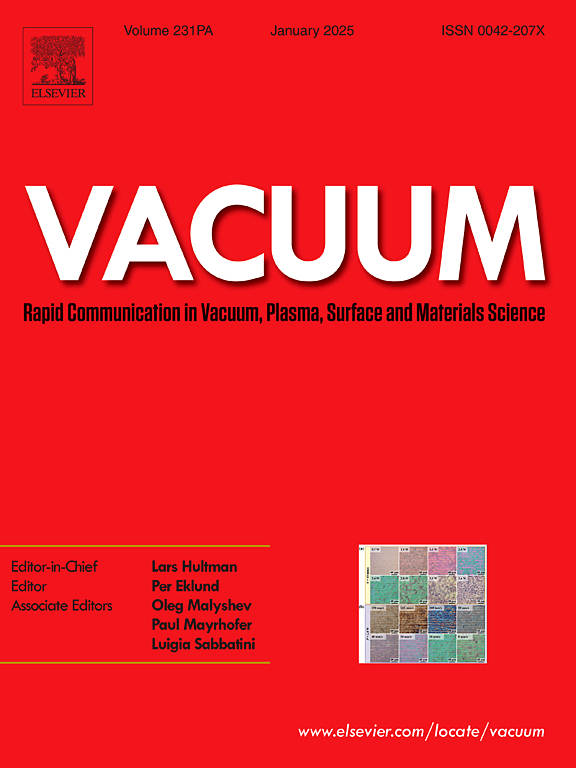Influence of discharge power and grid structure on an RF-biased ion thruster
IF 3.8
2区 材料科学
Q2 MATERIALS SCIENCE, MULTIDISCIPLINARY
引用次数: 0
Abstract
The RF-biased ion thruster applies radio-frequency (RF) power on the grid system, which can extract both ions and electrons to achieve self-neutralization. The performance of the RF-biased ion thruster is significantly influenced by the structure of the grid system and the discharge power since these factors play a crucial role in determining the focusing condition of the grid system. In this paper, the influence of discharge power and grid structure on the RF-biased ion thruster’s voltage parameters is investigated. According to the screen grid voltage waveform results under different discharge power and grid structure, the relationship between self-bias voltage and RF voltage is acquired. In order to explain the different waveform variations, the impacts of the direct impingement current as well as the oscillation of the upstream sheath voltage are considered in the theoretical calculation for self-bias voltage. It has been found that the opposite oscillation of the upstream sheath voltage is the primary reason for the decline in self-bias voltage. Moreover, the mechanisms through which discharge power and grid structure influence the self-bias voltage are explained in terms of their impact on upstream sheath oscillation. Several methods for increasing the self-bias voltage in RF-biased ion thrusters are also proposed.
放电功率和电网结构对射频偏压离子推进器的影响
射频偏压离子推进器在栅格系统上应用射频(RF)功率,可同时提取离子和电子以实现自中性化。射频偏压离子推进器的性能受电网系统结构和放电功率的影响很大,因为这些因素对决定电网系统的聚焦条件起着至关重要的作用。本文研究了放电功率和栅格结构对射频偏压离子推进器电压参数的影响。根据不同放电功率和电网结构下的屏幕电网电压波形结果,获得了自偏压与射频电压之间的关系。为了解释不同的波形变化,在自偏压的理论计算中考虑了直接撞击电流以及上游鞘电压振荡的影响。结果发现,上游鞘电压的反向振荡是自偏压下降的主要原因。此外,还从放电功率和电网结构对上游鞘振荡的影响角度解释了它们对自偏压的影响机制。还提出了几种提高射频偏压离子推进器自偏压的方法。
本文章由计算机程序翻译,如有差异,请以英文原文为准。
求助全文
约1分钟内获得全文
求助全文
来源期刊

Vacuum
工程技术-材料科学:综合
CiteScore
6.80
自引率
17.50%
发文量
0
审稿时长
34 days
期刊介绍:
Vacuum is an international rapid publications journal with a focus on short communication. All papers are peer-reviewed, with the review process for short communication geared towards very fast turnaround times. The journal also published full research papers, thematic issues and selected papers from leading conferences.
A report in Vacuum should represent a major advance in an area that involves a controlled environment at pressures of one atmosphere or below.
The scope of the journal includes:
1. Vacuum; original developments in vacuum pumping and instrumentation, vacuum measurement, vacuum gas dynamics, gas-surface interactions, surface treatment for UHV applications and low outgassing, vacuum melting, sintering, and vacuum metrology. Technology and solutions for large-scale facilities (e.g., particle accelerators and fusion devices). New instrumentation ( e.g., detectors and electron microscopes).
2. Plasma science; advances in PVD, CVD, plasma-assisted CVD, ion sources, deposition processes and analysis.
3. Surface science; surface engineering, surface chemistry, surface analysis, crystal growth, ion-surface interactions and etching, nanometer-scale processing, surface modification.
4. Materials science; novel functional or structural materials. Metals, ceramics, and polymers. Experiments, simulations, and modelling for understanding structure-property relationships. Thin films and coatings. Nanostructures and ion implantation.
 求助内容:
求助内容: 应助结果提醒方式:
应助结果提醒方式:


